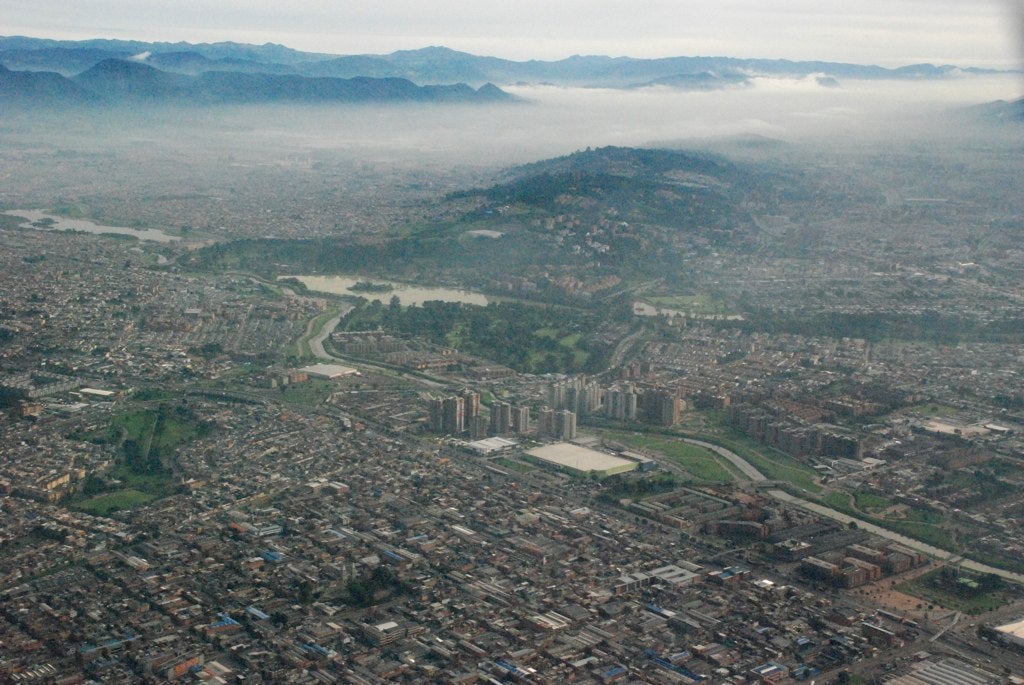Image courtesy of Justin Sovich/Creative Commons
Last week Bogota, Colombia, experienced an environmental and health crisis: due to air pollution, the city’s authorities activated a code yellow (in some places, even a code orange) and imposed restrictions on the circulation of cars. They explained that the poor air quality was a result of thermal inversions, unusually strong winds, and fires in the region. True as this may be, it is worth noting that all of these factors were presented as natural phenomena, whose harmful effects the government sought to counter by asking the population to temporarily change their routines.
The concern for Bogota’s air quality is old news. In August 2018, for example, magazine Semana published an article entitled “¿Qué respiran y de dónde proviene la contaminación de Bogotá?” (“What do you breathe and where does Bogota’s pollution come from?”), in which it discussed another display of concern regarding air quality by the government. This pub lication followed a statement by Colombia’s Environment Department in the previous month, recommending that the City Hall of Bogota take action to improve air quality. The article called attention to the fact that the average annual concentration of particle pollution in Bogota is almost twice the maximum proportion recommended by the World Health Organization. They went on to mention that the main sources of particle pollution in Bogota are forest fires, industrial combustion, and vehicle emissions of gasoline and diesel.
lication followed a statement by Colombia’s Environment Department in the previous month, recommending that the City Hall of Bogota take action to improve air quality. The article called attention to the fact that the average annual concentration of particle pollution in Bogota is almost twice the maximum proportion recommended by the World Health Organization. They went on to mention that the main sources of particle pollution in Bogota are forest fires, industrial combustion, and vehicle emissions of gasoline and diesel.
Not much time has passed since August 2018. If industrial combustion and vehicle emissions were a problem then, it is likely that they are still a problem. These are obviously men-made sources of pollution — and while natural phenomena might have played a role in last week’s air quality crisis, it is important to focus on the what can be controlled and improved. For example, the Semana piece talked about how calls for bids in public transport are unique opportunities to reduce the emissions of pollutants. The debate about which kind of vehicle to buy focuses largely on the costs, and naturally (and understandably) this is a huge part of decision-making. Environmental concerns are also extremely important, though unfortunately they are not always perceived as such. However, financial and environmental considerations are not always opposed. After all, an air quality crisis can be a compelling argument for people to stay at home, leading to considerable economic impact.
In last week’s air quality crisis, the measures in place did achieve their primary goal, and General Secretary Raúl Buitrago thanked the population of Bogota for observing the restrictions. He proudly announced that they had reached a 50% improvement in the city’s air quality and stressed the importance of this collective action when it came to protecting the health of vulnerable groups, such as children, pregnant women, the elderly, and the chronically ill. Though this immediate crisis has been handled, it is safe to assume it will happen again if nothing is done. There is no doubt that air quality has to do with human behavior, as there is also no doubt that people’s behavior is influenced by the public policies in place. In short, individual lifestyles and government choices are deeply intertwined.
Moving forward, air quality crises should be understood as an opportunity to rethink government choices. It is not only about the right to health or environmental protection (though these would be more than enough motivation to change the status quo), but about development models that are thinking ahead instead of catching up.



